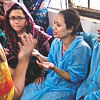When lifts become death traps

We are appalled to learn about yet another lift accident that injured 14 people, this time at the Dhaka District and Sessions Judge Court. A report in this daily quotes an executive engineer of the public works ministry which is in charge of the lift, opining that the lift collapsed due to overload . But an advocate of the Dhaka Bar Association has said that he had been telling the authorities of the court for a long time about the poor condition of the lift but nothing had been done. It seems that the usual suspect behind such horrific accidents is basically poor maintenance.
Thankfully, in this case, those trapped in the lift were rescued quickly by fire fighters and locals. But there have been many instances when such accidents have taken precious lives. Last March, seven-year-old Alvira was killed in a horrendous lift accident when the gates of the lift of the building she lived in slammed on her. In 2016, four people were killed and 20 injured when a lift crashed in the basement of an Uttara mall causing an explosion and fire. Experts have said that these crashes often are due to lack of routine maintenance and safety inspection by qualified professionals. This seems to be true of many other public and private buildings – both commercial and residential Thursday's accident and many others preceding it have proven how dangerous such a blasé attitude towards safety can be.
According to experts, there should be monthly maintenance and thorough inspection every six months to see if there are any faults such as loosening of the pulling cable, malfunction of the control system, sensors and motor of the lift. We urge the government to make it mandatory for all buildings with lifts to be inspected and maintained by the authorities in charge. It is unacceptable that lives will be endangered because of such gross negligence.

 For all latest news, follow The Daily Star's Google News channel.
For all latest news, follow The Daily Star's Google News channel. 







Comments